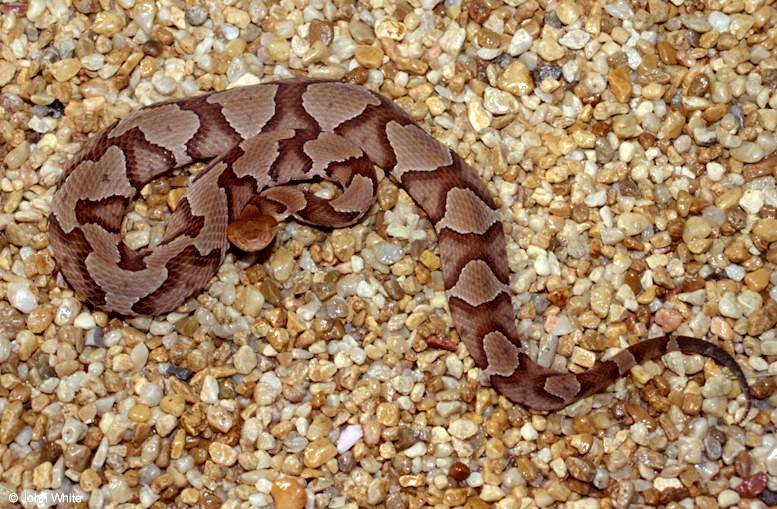NORTHERN COPPERHEAD
Scientific name: Agkistrodon contortrix mokasen
Size
The average size of a mature Northern Copperhead is 2-3 feet in length. Some reach up to 4 feet in length.
Description
The Copperhead gets it name from the copper-red color of the top of its head, similar to the color of a penny. The body of the Northern Copperhead is generally a light tan to reddish-tan, with dark brown to reddish-brown bands. These bands are hourglass shaped, being thinner across the spine and wider on the sides of the snake. The inside of the hourglass pattern is usually lighter on the sides of the body. There may often be one or two darker brown marks between the bands on the back of the body, and one inside the bands on the sides of the body. These marks are not as obvious as the banding, and are many times fainter in color or non-existent.
Young Northern Copperheads are patterned like mature Northern Copperheads, but are often grayer in color, and the tip of the tail on young Northern Copperheads is yellow. The yellow tail is used to attract food. It is wiggled in a motion imitating a worm or caterpillar, which attract frogs, lizards, or other prey that the young Northern Copperhead eats.
The Northern Copperhead has elliptical pupils that look like cat's eyes and like all pit vipers, has a heat-sensing pit between the nostril and eye on each side of its head. The Northern Copperhead has a large, triangular head that is wider than the neck when viewed from above.
Distribution
In the United States, the Northern Copperhead is found in most of the eastern states including
Alabama, Connecticut, Delaware, Georgia, Illinois, Indiana, Iowa, Kentucky, Maryland, Massachusetts,
Mississippi, Missouri, New Jersey, New York, North Carolina, Ohio, Pennsylvania, South Carolina, Tennessee, Virginia, and West Virginia.

Map does not show area of true distribution, only the states in which there is a population.
Actual distribution in any highlighted state may be limited.
Notes
When the Northern Copperhead is disturbed or feels threatened, it will often coil up its body, and raise its head at a 45-degree angle from the ground in a defensive posture. It will often vibrate its tail when disturbed as well.
The Northern Copperhead is born with the ability to bite and inject venom, and is fully capable of inflicting a venomous bite from birth.
A photo of a Northern Copperhead among the rocks.

Photo used by permission:
© 2002 John White
A mature Northern Copperhead. This photo displays the hourglass patterns well.

Photo used by permission:
© 2000 John White
A mature Northern Copperhead.

Photo used by permission:
© 2004 Jeremiah Easter
This close up of a Northern Copperhead's head gives an excellent view of the heat-sensing pit
located between the nostril and eye. Note the elliptical cat-like pupil of the eye.

Photo used by permission:
© 2001 John White
Below is a photo of a pair of Northern Copperheads. In this photo it is easy to see the copper-red color that
the Copperhead is named for on top of the head.

Photo used by permission:
© 2000 John White
Below is a photo of a young Northern Copperhead. The overall color of a young Northern Copperhead is typically
grayer. Note the yellow tail, which is used to attract food. Newborn Northern Copperheads are fully capable
of inflicting a venomous bite.

Photo used by permission:
© 2000 John White
For more information on venomous snakes, please see the Venomous Links page.
Terms and Conditions | Privacy Policy
Change your Cookies Preferences
